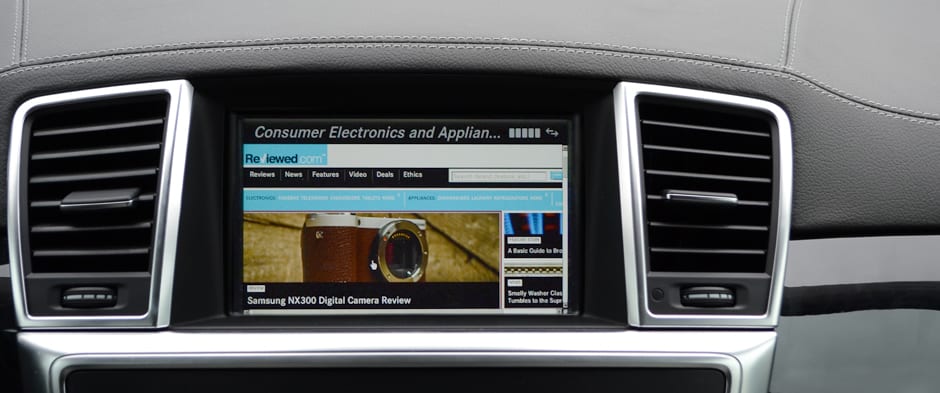Pros
Cons
Introduction
These people will be delighted to discover the Mercedes GL350 Bluetec. It has all the functionality of a luxury SUV—seven seats, tall ground clearance, a 7,500 lb. towing capacity, and a seating position high enough to look long-haul truckers in the eye—but a host of technology helps to eliminate any sense of just how absolutely massive this vehicle is.
Consider this: The GL weighs about 5,800 lbs., which is more than twice a base Toyota Corolla. The model we drove, which stickered slightly north of $82,000, came packed to the gills with a panoramic sunroof, massaging front seats, and two rear rows that fold themselves away at the push of a button to reveal more than 94 cu. ft. of cargo space.
Physics would dictate that the GL should handle like a drunken Yeti. But Mercedes' engineers proved physics wrong. They built a car that's as effortless to drive as a luxury coupe. Then, they gave it a diesel V6 capable of matching a high-end sedan in measures of fuel economy and acceleration. It's as remarkably decadent as outdoor air conditioning.
Tech & Entertainment
We drove the GL350 for a week in Cambridge and Boston, and had absolutely no problems fitting it down streets meant for horses and pedestrians, not elephantine SUVs. While a 40-ish-foot turning circle didn't hurt, we also appreciated the composite video feed from a host of cameras mounted around the vehicle. Just press a button, and the center LCD screen will show you three distinct views of just how many centimeters you have left between your bumpers and the car in the adjoining space. It also makes parking between the lines a breeze, which fellow motorists will surely appreciate.
If you still find parking impossible, spring for Parktronic with Active Parking Assist. It'll find parallel spots and automatically park the vehicle. It proved a bit finicky in our tests, refusing to recognize spots we knew were large enough, and even scraped the rear tire on a curb once (sorry, Mercedes, but it was the car's fault!) but watching this giant park itself proved mesmerizing from the driver's seat.
Every action that requires substantial effort, from parking, to folding down the rearmost seats to opening the trunklid, has been motorized and automated. With lane-departure warning, lane-keep assist, blind spot monitoring, and adaptive cruise control, it'd almost be possible to drive this car while in a full-body cast. Such tech has truly democratized the giant SUV—well, at least among people who can afford a car that costs as much as two or three Honda Civics.
{{photo_gallery "tech"}}
Unfortunately, Mercedes lags behind when it comes to infotainment. Our tester was equipped with an embedded data connection that runs Mercedes-Benz Apps without the need to tether a smartphone. The app lineup includes Yelp and a cloud-based POI search, but launching the software took so long (more than a minute!) I ended up just using my smartphone.
That would've been a laughable complaint just five years ago, but it proves that the likes of Toyota, Chevy and Honda have outdone Mercedes. App use also requires a $14 per month subscription on top of the $280 per year for the mBrace suite of telematics and remote safety features.
Design
The GL is far from the most attractive vehicle Mercedes has ever built. But a few exterior updates for 2013 have made the vehicle visually appealing in a utilitarian sense, like a well-designed locomotive. It also looks a lot more like a minivan than an SUV— and unless you need ground clearance, offroad abilities, or towing capacity, a minivan should be on your list. If it's just appearances you're concerned with, the Land Rover LR4 also seats seven, and looks like it's ready for a safari.
{{photo_gallery "exterior"}}
Inside, function also reigns supreme. There's enough legroom for adults in all three rows, and our tester featured climate control for three zones, too. Mercedes' brand-specific controls are still there: Owners of a '79 240D would know just where to find the cruise control stalk and power seat controls, but there's a slightly larger learning curve for those coming from other makes. We also weren't huge fans of the dark Eucalyptus trim's tendency to pick up fingerprints.
Driving Experience
At least in New England, the words "diesel Mercedes" tend to bring to mind a 30-year-old, smoke-belching wagon with lacrosse gear in the back and a rear window covered in prep school stickers. That's far from the powerplant at work here. The 3.0-liter turbodiesel V6 performs just like a gas engine, with no clatter and no cold weather issues, but a lot better fuel efficiency.
A urea-based fluid known as AdBlue reduces harmful nitrogen oxide emissions (hence the "Bluetec" badge) that have sandbagged diesel in the past. It's a synthetic compound, so there's no actual urea (just what you think it is) in your car, unless you couldn't find a gas station bathroom in time. You occasionally need to top off the AdBlue tank, which runs a few hundred bucks.
Won't that drive up the cost of the diesel, making it more expensive to run than the gas equivalent? Nope. EPA rates the GL350 at 19 city, 26 highway, 22 combined. Even though diesel tends to run more per gallon than gas, that's still a deal—especially considering gas-powered GLs require premium fuel. Our observed mileage, taken mostly from city driving, was closer to 18 MPG. That's not outstanding when compared against the majority of cars on the market, but it's a whole heck of a lot better than the 14 MPG city rating the EPA gives the gas-powered GL450.
In fact, all costs taken into account, a study by the University of Michigan (PDF) commissioned by engine component manufacturer Bosch shows that a diesel GL could save an American consumer $13,514 over a gas-powered counterpart over the course of just three years.
{{photo_gallery "interior"}}
Mercedes claims the diesel V6 can move the giant GL from 0-60 in around eight seconds—though we'd argue most of that acceleration takes place in the latter six or so. Turbo lag—the short time it takes for a turbocharged engine to "spool up"—is a minor issue here, and the lack of instantaneous acceleration from a stop can be a bit unnerving until you get used to it.
Still, we can't imagine why anyone would choose to buy a gas-powered GL. Comparatively speaking, the diesel is so remarkably efficient, and the drawbacks are minimal. I hope I never run into any gas-powered GL owners at a cocktail party after I've had a few gin and tonics, because I'll be sure to grill them on their choice of vehicle. That shouldn't be a problem, as I'm rarely invited to cocktail parties.
As far as handling is concerned, the GL truly impresses. With seven passengers on board, I tossed it around like I would a sedan, and it complied with virtually no body roll or lean. The air suspension had no problem swallowing up bumps while still remaining responsive enough to keep me appraised of what was going on outside the vehicle—important when piloting nearly three tons of metal.
Conclusion
The GL350 Bluetec is a remarkable feat of engineering. In fact, it's so remarkable that I fear it'll become the norm, the way that the ubiquitousness of air travel has taken some of the wonder out of stepping into a metal tube in New York, blasting through the air eight miles in the sky, and grabbing a beer in Munich eight hours later.
In that vein, I've got some qualms about whether a three ton SUV is really the best choice for family transport. The price is certainly a barrier to entry for most folks, but there's nothing else about this car that would make it any harder to own than a family sedan. If you enjoy staring down at the roofs of cars ahead of you, or frequently carry larger-than-average loads of passengers or stuff, it's preferable to other choices out there.
Imagine what that means: A world full of seven-passenger SUVs, twice the size of bestselling sedans, hurtling along the highways, getting respectable gas mileage and requiring minimal input from drivers. Heck, GL owners don't even have to know how to parallel park. Essentially, the new GL has been so well engineered that it no longer commands respect. Considering how much work has gone into it, that's a shame.
Trim Levels
Mercedes offers a dizzying array of options and trim levels on the Tuscaloosa, AL-built GL-class. There's only one diesel option, the GL350 Bluetec ($62,400 starting MSRP), but options can easily add $20,000 to that base price. Highlights include the $3,500 Premium Package which adds navigation, the $1,290 Parking Assist Package for Surround View and Active Parking Assist, and the $2,800 Driver Assistance Package for adaptive cruise control and lane-keep assist.
As far as gasoline engines are concerned, there's the GL450 that comes with a twin-turbo 362-hp V8 ($63,900 base MSRP), a GL550 that adds a 429-hp V8 ($86,900 starting MSRP), and the insanely extravagant GL63 AMG , which adds a whole host of performance upgrades including a handbuilt 557-hp V8 ($116,925).
Powertrain
There's only powertrain available on the GL350: a 3.0-liter diesel V6 mated to a seven-speed automatic transmission, with Mercedes' 4MATIC all-wheel drive. Every other engine choice also gets a seven-speed transmission and 4MATIC, but the AMG gets an exclusive "SpeedShift" transmission with three driving mode options: Controlled Efficiency for maximum fuel economy (ha!), Sport, and Manual for use with paddle shifters.
Safety
Neither NHTSA nor IIHS has tested any model within the GL-class.
Fuel Economy
The diesel GL350 is rated at 19 city, 26 highway, 22 combined. The gas-engined GL450 is rated at 14 city, 19 highway, 16 combined, while the GL550 loses one further MPG on all measures. The GL63 AMG is rated at 13 city, 17 highway, 14 combined. That puts it among the worst-rated passenger vehicles for sale in the US when it comes to fuel economy.
Meet the tester
Keith was the Editor in Chief of Reviewed's appliance and automotive sites. His work has appeared in publications such as Wired, Car & Driver, and CityLab.
Checking our work.
Our team is here to help you buy the best stuff and love what you own. Our writers, editors, and experts obsess over the products we cover to make sure you're confident and satisfied. Have a different opinion about something we recommend? Email us and we'll compare notes.
Shoot us an email

